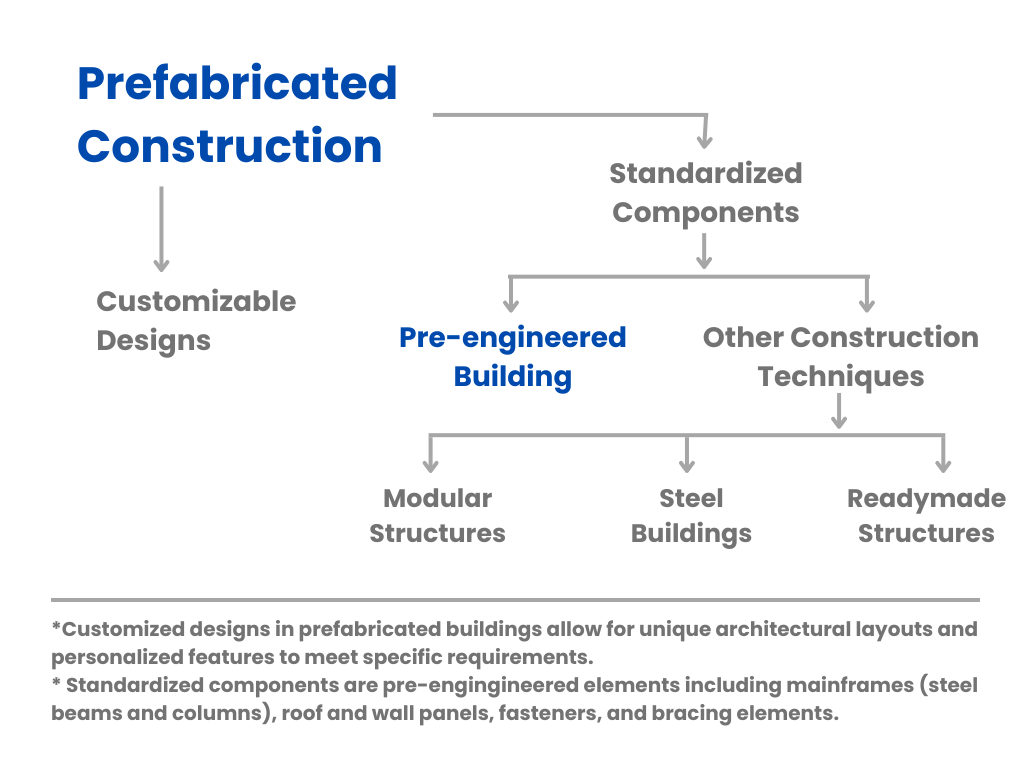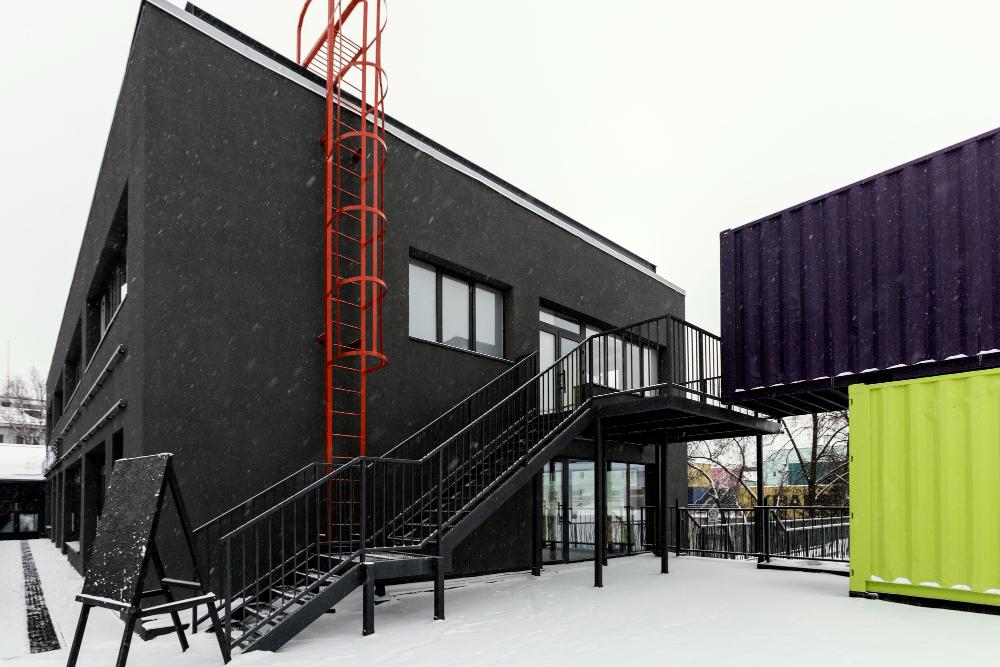Are you uncertain about what prefabricated and pre-engineered buildings are and what are the differences between them? Picture this: you’re a business owner starting to expand, and you need to construct a new facility quickly. Your mind is buzzing with questions: Which option should you choose? What are their benefits and limitations? Don’t worry – we’ve got you covered.
In this blog, we delve into the world of prefabricated and pre-engineered buildings. We’ll explore the nuances between these two popular construction methods, helping you make an informed decision for your project. Whether you’re in the market for a commercial space, storage facility, or even a residential building, understanding these options is essential. By the end of this blog, you’ll have the knowledge and confidence to choose the right construction solution for your specific needs.

Flowchart illustrating the hierarchy of prefabricated construction
What are prefabricated buildings?
Prefabricated building, also known as prefab buildings or modular buildings, are structures that are manufactured off-site in a factory setting. These buildings are designed and fabricated in standard sections or modules, which are then transported to the construction site for assembly.
Benefits of Prefabricated Buildings
1. Efficiency: Prefabricated buildings are built using efficient construction processes. The standardized modules allow for streamlined production and reduced construction time.
2. Cost-effective: Due to the controlled manufacturing environment, prefabricated buildings can be produced at a lower cost compared to traditional construction methods. This makes them an attractive option for cost-conscious businesses.
3. Flexibility: Prefab buildings offer flexibility in terms of design and configuration. The modular nature of these structures allows for easy customization and expansion, making them an adaptable solution for various applications.
4. Quality Control: Since prefab buildings are constructed indoors under strict quality control measures, the materials and workmanship can be closely monitored, ensuring a higher degree of quality and consistency compared to on-site construction.
Benefits of Prefabricated Buildings
5. Speed of Construction: Prefab buildings can be completed significantly faster than traditional construction. The controlled production environment allows for concurrent activities, resulting in shorter project timelines.
6. Reduced Site Disruptions: Since the majority of the building components are manufactured off-site, the on-site disruptions, such as noise, debris, and traffic congestion, are minimized, leading to a more organized and efficient construction process.
What are pre-engineered buildings?
Pre-engineered buildings (PEBs) are a type of prefabricated building structure that is designed and manufactured off-site, utilizing a precise and standardized process. PEBs are constructed using advanced engineering techniques, such as computer-aided design (CAD) software and computer-aided manufacturing (CAM) technology. This enables the building components to be manufactured in a factory-controlled environment, ensuring high-quality and consistent results.
Note: PEBs are designed to be versatile and customizable, meeting the specific requirements of different industries and applications. The components of a PEB, including columns, rafters, beams, and wall panels, are fabricated to exact specifications and are ready to be assembled on-site. This prefabrication process allows for faster construction times and increased efficiency compared to traditional construction methods.
Benefits of Pre-engineered Buildings
1. Cost-Effective: The prefabrication process used in PEBs helps to reduce construction costs significantly. With the ability to mass-produce standardized components, materials can be purchased in bulk, leading to cost savings. Additionally, the faster construction time associated with PEBs translates into reduced labour costs.
2. Customization: Despite being prefabricated, PEBs offer a high level of customization. The design and layout of a PEB can be tailored to meet the specific needs of the client. This flexibility allows businesses to create a building that maximizes space utilization and functionality.
3. Quality Control: PEBs undergo rigorous quality control measures during the manufacturing process. With strict adherence to engineering and design standards, the end result is a building that meets or exceeds industry regulations. This ensures structural integrity and longevity.
4. Time-Efficient: One of the major advantages of using PEBs is the reduced construction
time. Since the building components are prefabricated, the time required for on-site assembly is significantly reduced. This enables businesses to expedite their construction projects, saving time and increasing operational efficiency.
5. Sustainability: PEBs are known for their sustainable qualities. The manufacturing process generates less waste compared to traditional construction methods. Moreover, the design and fabrication of PEBs often incorporate energy-efficient features, such as insulation and natural lighting, reducing energy consumption and environmental impact.
6. Durable: Additionally, pre-engineered buildings offer excellent durability and strength. The materials used in their construction undergo rigorous testing to ensure they meet high-quality standards. This makes them resistant to harsh weather conditions, earthquakes, and other natural disasters.
Key differences between prefabricated and pre-engineered buildings
| Aspect | Prefabricated Buildings | Pre-engineered Buildings |
| Manufacturing Process | Components are manufactured off-site in a factory setting. | Components are manufactured off-site following standardized designs and guidelines. |
| Construction Process | Components are transported to the site and assembled. | Components are assembled on-site according to pre-engineered designs. |
| Design Flexibility | Highly flexible design options, can be easily customized. | Customizable designs within engineering constraints based on pre-engineered standards. |
| Material Options | Can be made from various materials like steel, wood, concrete, etc. | Primarily made of steel, offering strength and durability. |
| Construction Time | Construction time may vary depending on complexity and size. | Typically faster construction due to pre-engineered components. |
| Cost | Costs can vary depending on customization and materials used. | Generally cost-effective due to standardized design and efficient manufacturing. |
| Building Size | Suitable for small to large-scale projects. | Ideal for medium to large-scale buildings. |
| Engineering Involvement | May require engineering analysis for complex custom designs. | Engineering is integral to the standardized design and construction process. |
| Aesthetics | Can be designed to various architectural styles. | Aesthetic choices may be limited due to pre-engineered nature. |
| Applications | Used in residential, commercial, and industrial projects. | Commonly used for industrial, commercial, and storage structures. |
Conclusion
Now that you understand the difference between prefabricated and pre-engineered buildings, whether you choose a prefabricated or pre-engineered building will depend on factors such as budget constraints, timeline considerations, site conditions, and desired aesthetics. By understanding the differences between prefabricated and pre-engineered buildings, you can make an informed choice that best suits your needs. Remember that there is no one-size-fits-all solution when it comes to construction projects – each option has its own set of benefits and considerations.
“Contact Pressmach Infrastructure Pvt Ltd today to explore the benefits of prefabricated buildings and make an informed decision that aligns perfectly with your unique project goals!”



